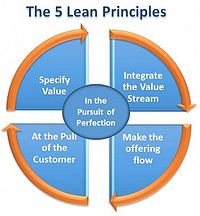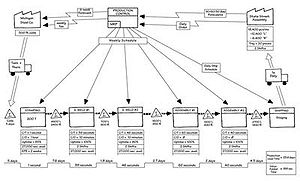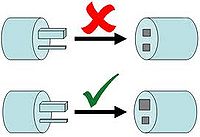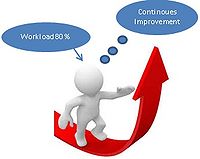Lean Tools in Project Management
This article covers the basic principles of Lean Thinking, and describes which tools and techniques there are available in Lean Project Management. The purpose of the article is to give an overview of Lean Thinking and how to approach the Lean Tools in Project Management. The article contains a description of the background of Lean, tools and techniques, and how to approach Lean Thinking in Project Management. However Lean Thinking philosophy was originally described in the automotive industry, the topics will explain how the originally philosophy of Lean is used as tools in Project Management. The two main topics in this article are Lean Thinking and Project Management and the definitions of these are:
The definition of Lean Thinking: To maximize the customer value, while elimination waste. Create more value with fewer resources.[1].
The definition of Project Management: Planning, organize, motivate and control the resources to achieve a specific goal of a temporary project and within the specific criteria.[2]
The article is a combination of these two definitions and provides a clear picture of why these two topics are linked and why this is an interesting topic.
Contents |
Background
Introduction to Lean
Lean Thinking is the philosophy from the Japanese automotive industry and was introduced in the very late 1930’s as the Toyota Production System (known as TPS). Lean is basically about creating value for the customer by eliminating waste. An organization which has fully adopted the Lean philosophy understands what activities creates value for the customer and what is the customer willing to pay for. The target in every lean project is to reduce or minimize the waste, so there is zero waste and additionally reducing the variation in any of processes in the system. The philosophy really attracted companies, when the small local Japanese company became one of the leading automotive manufacturing companies in the world. The TPS system was in the beginning dedicated to the manufacturing industry, but during the past years has the philosophy been established as an overall optimization philosophy for all kind of business’. The five principles of the philosophy are described below and an picture of the principles are shown in figure. 1.[3]
| The Five Lean Principles [4]. | Description |
|---|---|
| 1. Specify Value | Specify Value is about understanding that only small amount of the time you spend in the company that adds value to the customer. This is mainly about eliminating all the non-value activities, known as waste, and furthermore identify what activities which make for the specific product or service. |
| 2. Integrate the Value Stream | Value Stream Mapping is while all the activities of the product or service are identified from the very beginning of its lifecycle across all the processes. An overview of all the non-activities will be visualized in a Value Stream Mapping Model. |
| 3. Create Flow by Eliminating Waste | Create Flow by Eliminating Waste ensures the flow of the product with only value added activities. While Lean Thinking is focusing by eliminating the waste, this principle can only be achieved if all the different waste has been eliminated. |
| 4. Establish Pull | This is a part of the "Just In Time", which is important to know. Just-in-time (JIT) concept is from 1950s, and is part of the "Toyota Production System" (TPS). JIT originally had much focus on the times for their supply, production and customers. The materials for the production should be available "just in time", exactly when the need for them to be a "pull" system. Understanding what customer wants, when the customer wants it will secure a low inventory. |
| 5. Seek Perfection | After achieving the first four principles continuous improvements must be a part of the philosophy. The aim must be zero waste although its difficult to archieve. To achieve the most "Lean" organization, involve every employee within your company which is a part of the value stream and implemented the mindset in all departments. |
An implementation of the Lean Thinking principles in any organization should result in these overall goals listed below:
- - Improve quality
- - Eliminate Waste
- - Reduce Lead time
- - Reduce Total Cost
Lean Thinking and Lean Project Management have the same overall; to eliminate waste. To a achieve the goals of Lean Thinking, Lean Tools are powerful and can be applied in Project Management. The next topic will cover the difference of wastes in Lean Thinking and Lean Project Management.
Elimination of Waste
This topic is significant because the purpose of applying Lean Tools in Project Management is to Eliminate Waste, known as Muda in Japanese Terms. A description of the various of waste there are in Lean Thinking is listed below. Furthermore there is a description of wastes in Project Management.
| Waste in Lean Thinking [5] | Waste in Lean Project Management |
|---|---|
| - Transportation, every time when a product moves. Damaging of products, delays, etc. | - Status meetings, which are ineffective and too long to keep the participants interested. |
| - Inventory, raw material, work-in progress or finished goods, which is cost and does not create value to the customer. | - Too detailed plans. The schedule usually changes during a project period and it waste of time and a huge amount of rework. |
| - Waiting. If a process or product is not in progress. | - Collecting inoperable data, this will never be used. |
| - Over-processing. occurs when more work is done and its not required by the customer. | - Push subproject and meetings, which ties up the team members and only satisfying the stakeholder but increasing the duration of the project. |
| - Over-production. Producing more than the total demand of the product from the consumer. | - Documentation which is never used. |
| - Defects. Creates extra cost and extra labor from the producer. |
Lean Project Management
The 8 different relates mainly to the production, not specific, there are some similar kind of waste in project management. Waiting, over processing and defective process are in any business where an implementation of the lean philosophy takes place. The creation of something the customer does not value is a waste. Waste in project management might be:
- - Status meetings, which are ineffective and too long to keep the participants interested
- - Too detailed plan. The schedule usually changes during a project period and it waste of time and a huge amount of rework.
- - Collecting inoperable data, this will never be used.
- - Push subproject and meetings, which ties up the team members and only satisfying the stakeholder but increasing the duration of the project.
- - Documentation which is never used
The goals of project management are to reduce the cost of the project or complete the project on budget. Furthermore the project must be completed on the estimated time and meet the performance requirements as agreed before the project began. To meet these expectations and requirements, the most efficient way to achieve this is by using tools, techniques and methods.
Lean Tools in Project Management
This section covers Lean Tools that can be applied in Lean Project Management. These tools which are described below, helps to reduce the waste and the variation of the processes. Furthermore these tools can help to identify potential improvement of processes and assist to a better understanding in the company of the products life cycle. Not every "Lean" tool is applicable in Project Management, but some tools can be used in Project Management and those are listed. [6]
Value Stream Mapping
Visual Management in Project Management provides a lot of information quickly. Furthermore it's easier to remember information when it's presented visually. Value Stream Mapping (VSM) is a visual technique to map the current processes. VSM gives a current state view of the processes and gather information as; cycle times, inventory levels, down times, material flows and information flows. This technique can be used in different levels, such as the entire supply chain or a production area. The tool mapping all the non-valued activities as well as all the valued activities. The target is to achieve a future state sceneria by using other lean tools. Figure 3 shows a very detailed plan of a Value Stream. The Map informs many different common VSM symbols, which is used to portray material and information flow.
Kaizen
While Value Stream Mapping gives an overview of the current activities, Kaizen Events are useful for conducting the improvements of the activities. Kaizen events are generally a short-term projects, which takes place in a period of 3 - 5 days. The objective is to improve a minor process and the scope is small. Workers which are closets to the current process are key players in these projects. New strategies, techniques and equipment are not introduced in these events, those are introduced in Kaikaku Events, where the scope is larger and the more radically changes are made.
The Gemba Walk
Gemba Walk is a powerful tool, where the Lean Manager physically visits the production floor. The manager goes to the production and walks through the entire value stream. There are numerous of reasons why this is a great tools, for instance; The Lean Manager is not familiar with the process and have another view of the process. Furthermore, when the Lean Manager visits the production floor does it give a positive motivation impact on the employee and the worker feels valued because the manager puts this attention to the process. The Gemba Walk avoids the PowerPoint presentations and goes directly to the problems.
System Optimization
This mythology is a part of the Value Stream Mapping. Optimization is not only on a particular workstation of specific area, but considering the entire value stream, and identify what improvements will affects other workstation and which will not. The goal is to create improvements without affect any other areas and create a standardization of it.
Poka-Yoke
Poka-Yoke is a Japanese tool, which helps the workers to avoid mistakes. For instance, plugin a battery into headphones. The “Poka-Yoke” is that the headphones do not allow the process to begin after the mistakes has occurred. Therefore the consumer of the headphones cannot listen to music before the battery orientation is proper. An another example is shown in figure 3, where the image shows how its only possible to plugin the power outlet in one way. [7].
Summary
The explanation and the description of the applicable Lean Tools for Project Management listed above give an idea of how to approach these tools. These can be used as analytical methods, planning-, and problem-solving approaches. [8]
Summarizing two of the factors in these Lean Tools, which can be applied in Project Management:
- Lean Tools gives an understanding of the current processes and help to a better understanding of improvements. In order to understand this, it is required to make a current state of the processes.
- Lean practices can be applied in any kind of business and projects. It's only depends on the workers and the project managers creativity.
Consequences
Advantages
Applying Lean Tools in Project Management provide competitive advantages. Space saved on warehousing, reducing cost, improving efficiency, time savings, faster responding to changes and elimination of waste are some of the major advantages by using the tools listed above. New production lines might be added while more space from the warehouse is available. In addition, the employees develop new skills and can respond quicker to changing demand from customers. [9]
Limitations
- Inefficiency
Lean can be abused and overused. Lean can often become a goal itself, although the value of the improvement just moves the bottleneck to another process. Lean must be a trade of between the value of the improvements and the resources in the current situation. Some companies believe that Lean tools can be applied in their organization from the next day, but the companies forget to remember that Toyota has spent more than 50 years on achieving a “Lean” Production, and Toyota has still room for improvements. While running Lean Tools in organization, the project managers have to be patient with the improvement activities which are initiated.
- Problem Delivering the Right Product on the Right Time (Just In Time)
"First stabilize then optimize" is a common proverb in Lean context. Unfortunately, some companies facing optimizing and then stabilizing, which is wrong and might have major impacts on delivery times etc. For instance, if a company has uncertain delivery of raw materials, and does not have raw materials for production, then it interrupting the production flow and delaying all other processes. Therefor being aggressive with "Just in Time" might leave bottlenecks in the overall Value Stream.
- Employees Frustration
Discouraging employees by using lean methods can be a problem. The managers squeezing the economy from the production and discourage the employees. Continue Improvements must be a part of the workflow, but not a strain on the workers and this can be challenging in a lean environment. In a lean environment the workload of the single worker must around 80 % every day. The last 20 % should be free for change or enhancement measures. [10]
Additional Reading
Books
- Lean Thinking. By James P. Womack and Daniel T. Jones. 2003. ISBN 978-0743249270 - One of the most famous books about Lean, especially the authors. Must read to get a detailed and overview of lean.
- Gemba Walk. By James P. Womack. ISBN 978-1934109151 - Great examples from Womack. Womack gives som great examples from the real life. Particularly when he steps into the first company, and explains how he did the "Gemba Walk" and how badly the company performed (Page 48-75). This book is available at The Technical University of Denmark's' library.
Websites
- Elimination of Waste - Get a fast overview of Lean Thinking in Project Management.
- Lean Principles - If you are not into reading, then you can find some pretty good examples on YouTube. This video might give powerful understanding of Lean.
References
- ↑ http://www.lean.org/WhatsLean/, accessed: 23-09-15
- ↑ The Definitive Guide to Project Management. Nokes, Sebastian. 2nd Ed.n. London (Financial Times / Prentice Hall): 2007. ISBN 978-0-273-71097-4
- ↑ Lean Thinking. By James P. Womack and Daniel T. Jones: 2003. ISBN 978-0743249270
- ↑ http://leanmanufacturingtools.org/39/lean-thinking-lean-principles/ , accessed: 23-09-15
- ↑ Toyota Production System, Ohno, Taiichi, 1988, Productivity Press ISBN 978-0915299140
- ↑ http://projectmanagement.atwork-network.com/2012/03/16/lean-tools-and-techniques-for-project-management/, accessed: 25-09-15
- ↑ http://www.lsvgroup.com/site/index.php/da/viden-om-1/vaerktojer/147-poka-yoke-1, accessed: 26-09-15
- ↑ Leading and Managing The Lean Management Process, Fliedner, Gene, 2011, Business Expert Press, New York, ISBN 978-1606492482
- ↑ http://www.lean-manufacturing-japan.com/ , accessed: 26-09-15
- ↑ http://www.businessknowledgesource.com/manufacturing/lean_manufacturing_techniques_pros_and_cons_025561.html , accessed: 26-09-15



